The Event Horizon Telescope (EHT) — a planet-scale array of eight ground-based radio telescopes forged through international collaboration — was designed to capture images of a black hole. In coordinated press conferences across the globe, EHT researchers revealed that they succeeded, unveiling the first direct visual evidence of a supermassive black hole and its shadow. The shadow of a black hole seen here is the closest we can come to an image of the black hole itself, a completely dark object from which light cannot escape. The black hole’s boundary — the event horizon from which the EHT takes its name — is around 2.5 times smaller than the shadow it casts and measures just under 40 billion km across. While this may sound large, this ring is only about 40 microarcseconds across — equivalent to measuring the length of a credit card on the surface of the Moon. Although the telescopes making up the EHT are not physically connected, they are able to synchronize their recorded data with atomic clocks — hydrogen masers — which precisely time their observations. These observations were collected at a wavelength of 1.3 mm during a 2017 global campaign. Each telescope of the EHT produced enormous amounts of data – roughly 350 terabytes per day – which was stored on high-performance helium-filled hard drives. These data were flown to highly specialised supercomputers — known as correlators — at the Max Planck Institute for Radio Astronomy and MIT Haystack Observatory to be combined. They were then painstakingly converted into an image using novel computational tools developed by the collaboration.
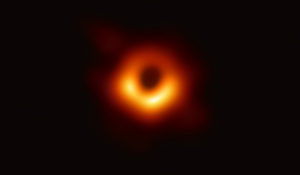
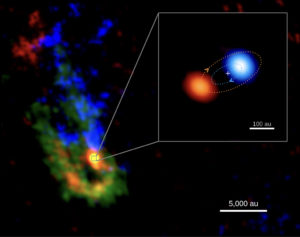
ALMA Image of Young, Massive Binary Star System
ALMA image of the IRAS-07299 star-forming region and the massive binary system at its center. The background image shows dense, dusty streams of gas (shown in green) that appear to be flowing toward the center of the system. Gas that is moving toward us — as traced by the methanol molecule — is shown in blue; motions away from us in red. The inset image shows a zoom-in view of the massive forming binary, with the brighter, primary protostar moving toward us shown in blue and the fainter, secondary protostar moving away from us shown in red. The blue and red dotted lines show an example of orbits of the primary and secondary spiraling around their center of mass (marked by the cross).
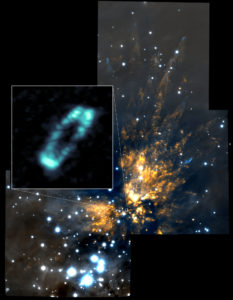
ALMA Image of Salt in Orion Source I
ALMA image of the salty disk surrounding the young, massive star Orion Source I (blue ring). It is shown in relation to the Orion Molecular Cloud 1, a region of explosive starbirth. The background near infrared image was taken with the Gemini Observatory.
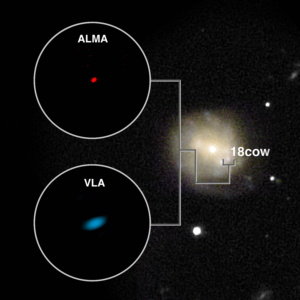
ALMA and VLA Images of AT2018cow
ALMA and VLA images of the mysterious new type of cosmic blast, AT2018cow at left. Visible-light image of outburst in its host galaxy at right. Images not to same scale. Images of the blast itself do not indicate its size, but are the result of its brightness and the characteristics of the telescopes.
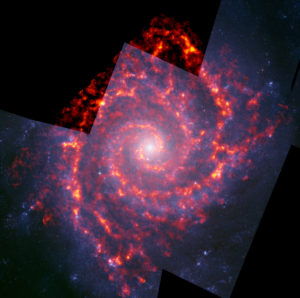
NGC 628, PHANGS-ALMA and HST Composite
Composite ALMA (orange) and Hubble (blue) image of NGC 628, also known as Messier 74, a spiral galaxy in the constellation Pisces, located approximately 32 million light-years from Earth. It is imaged as part of the PHANGS-ALMA survey to study the properties of star-forming clouds in disk galaxies.
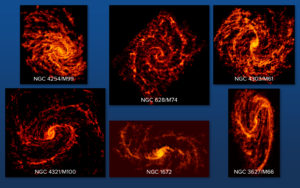
PHANGS-ALMA Survey Sample Galaxies
Six ALMA-imaged galaxies out of a collection of the 74. The images were taken as part of the PHANGS-ALMA survey to study the properties of star-forming clouds in disk galaxies.





